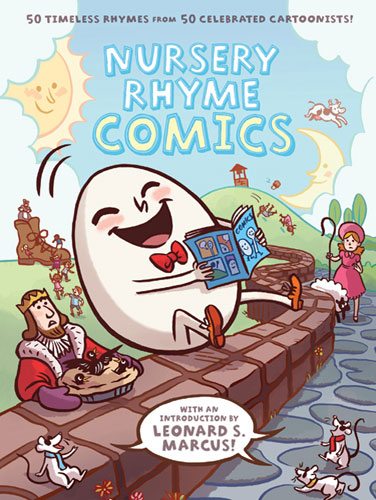Welcome! This post launches a new column, one I’ve wanted to do for years.
KinderComics will focus on visual narratives aimed at and/or depicting children, most especially comics. The impetus for this column is twofold:
- The recently expanded, not to say exploding, interest in children’s comics evinced by publishers, librarians, teachers, and, of course, readers and reading families.
- Awareness of the aesthetic and historical relations among comics, picture books, animation, and other media that weigh heavily in children’s culture.
Of course comics will outweigh other media here, as befits TCJ. However, at times I’ll divert to allied forms or genres that, again, stress visual narrative, children as a presumed audience, or the depiction of childhood. I may also discuss relevant scholarship, including criticism, history, and theory. Mainly, I expect to review comics published for children.
My interest in this area—these overlapping areas, rather—is rooted in comics but informed by my teaching and research in children’s culture, examples of which may be found here and here. I teach children’s literature at CSU Northridge, and belong to the Children’s Literature Association. For years I’ve argued that the synergy between comics and children’s books warrants a more vigorous and informed criticism, and that’s what I hope to model here. (Note that I’ll be assuming an adult readership, and, as I do when teaching children’s literature, may tackle issues some readers would prefer their young children not to read about.)
Again, welcome! My inaugural post concerns:
Nursery Rhyme Comics. Edited by Chris Duffy; designed by Colleen AF Venable. Introduction by Leonard S. Marcus. First Second, 2011. US $18.99. 128 pages, hardcover.
Nursery Rhyme Comics boasts a stunningly diverse bunch of contributors, fifty in all, drawn from children’s books, comics, gag cartooning, and animation. All of them, as the title promises, contribute comics—one, two, or three pages long each—adapting traditional rhymes. Edited by cartoonist Chris Duffy, the book evokes his former work as the comics editor for Nickelodeon Magazine, where he assembled a terrific, ecumenical mix of cartoonists, many of them from the alternative scene. The comics section from Nickelodeon is fondly remembered for its eclecticism, good humor, and wild cartooning—qualities on view in Nursery Rhyme Comics as well. The idea for the book, we’re told, came from Lauren Wohl, marketing maven and formerly associate publisher of First Second, and of course it’s a natural. Duffy, though, has carried it forward with special care. Handsomely turned out, Nursery Rhyme Comics boasts typically sharp design from Colleen Venable, and presents a lovely, enticing object. The introduction by critic and historian Leonard S. Marcus (Minders of Make-Believe, etc.) is likely to make it even more enticing to readers steeped in children’s literature studies.
Unified design aside, Nursery Rhyme Comics is a crazy quilt of a book. Any volume that hosts—don’t hold your breath—Kate Beaton, Nick Bruel, Roz Chast, Jules Feiffer, Gilbert and Jaime Hernandez, David Macaulay, Patrick McDonnell, Mike Mignola, Stan Sakai, Craig Thompson, Richard Thompson, and Gahan Wilson, among many others, constitutes, first, a miraculous stunt, and, second, a bonafide event. Nursery Rhyme Comics is undeniably an editor’s project, one that bespeaks a deliberate editorial vision and no doubt involved prospecting and cajoling many, many artists. I have to say, it does pay the usual price for that: not everything in the book works equally well, and in places there are signs, frankly, of editorial overcaution. Some of the potential rawness promised by nursery rhymes has been refined away (a point I’ll return to). Yet, for all that, NRC contains a great deal of inventive, elegant, and charming work.
(Continued)








